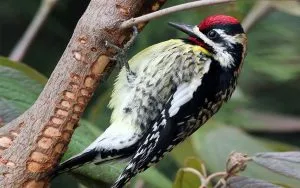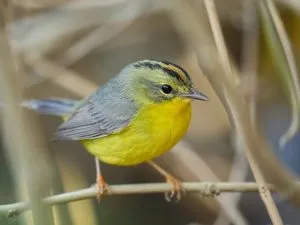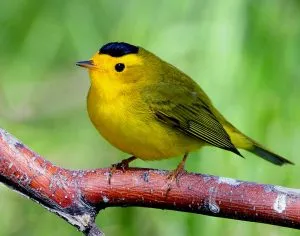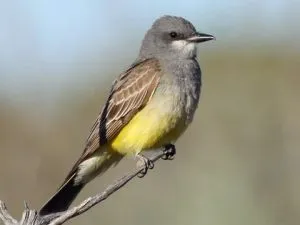Last Updated on: February 4, 2025
Bright and cheery, birds with yellow bellies will add color to any backyard. They are a visual treat not only in the garden but also in their natural habitats, such as forests and marshes.
But…
The identification of a bird with a yellow belly can be confusing. Warblers and orioles are some of the most popular, but if you dig deeper, you will find out that a lot of other species exist.
Do not be confused the next time you see yellow-bellied birds. Read on and we’ll let you know some of the species you will find.
A Guide To The Identification Of Birds With Yellow Bellies
1. Yellow-Bellied Flycatcher

A small bird from the flycatcher family, it is known for its preference for deep shades, unlike its relatives that like open and sunny spaces.
The yellow-bellied flycatcher is compact with an average length of 5.1 to 5.9 inches. Meanwhile, its wings can extend from 7.1 to 7.9 inches.
Aside from their yellow bellies, these birds are easy to identify with their dull olive-green underparts and white streaks on their wings.
It is common to see yellow-bellied flycatchers in dense forests where they are perching on lower and middle levels. They are also living in peatlands, swamps, and bogs, especially during the breeding season.
2. Yellow Warbler

The most widespread out of American wood warblers, yellow warblers are small birds with bright yellow bodies. Males are differentiated from females through the cinnamon streaks on their chest.
Their habitats are varied, which can include wetlands and streams, especially those along field edges. These are the most frequent places where they will forage for different insects, including wasps, bugs, beetles, and caterpillars.
Yellow warblers are common birds, and hence, you will see them in a lot of places in North America. However, in the winter, they will migrate to Central and Northern South America.
3. Yellow-Bellied Sapsucker

Unlike most of the species on this list, the yellow-bellied sapsucker isn’t too bright. It has a pale yellow chest with markings, which is almost impossible to miss if you do not look closer. The yellow-bellied sapsucker is a small woodpecker. It has a stout and straight bill. Meanwhile, the wings are long and pointed at the tail when resting.
These birds have black and white patterns throughout their bodies. Both males and females will have red foreheads. On the other hand, only males will have red throats.
You will see them perching on trees in an upright position and leaning on its tail in the wild. This is a behavior that is common in woodpeckers.
4. Prairie Warbler

While it is a small songbird, the vibrant yellow chest of a prairie warbler makes it easily noticeable even from afar. Other physical identifiers include the olive-green wings and upper body, long tail, long legs, and a straight bill.
The diet of a prairie warbler is mostly insects, including tree crickets, moths, caterpillars, true bugs, lacewings, ants, flies, and beetles. However, it will also eat spiders and bellies. Occasionally, it will take sap from trees.
With its name, most people will think that they live on prairies. However, their habitats are open woods and scrubby fields.
5. Golden-Crowned Warbler

While it is possible to find golden-crowned warblers in North America, they are not native to the country. Instead, they are from South America, Central America, and Mexico.
The golden-crowned warbler is a small bird with a short tail. It has three black stripes on the top of its head, which looks like a crown. Their wings and back are dark gray.
Golden-crowned warblers are highly active when they are foraging. They are gregarious and will form small groups when hunting for food.
6. Magnolia Warbler

While magnolia warblers are not as easily recognizable as other warblers, they are easy to spot. You do not need to look far as they like hanging out on low branches.
It is common to see a magnolia warbler fanning its tail, which will reveal wide white patches on the side.
The most common breeding habitats of magnolia warblers are in small conifers, specifically young spruces. During migration, on the other hand, they are most common in places with dense vegetation.
Like most warblers, insects form the majority of the diet of a magnolia warbler. Occasionally, especially during inclement weather when insects are scarce, they will also eat berries.
7. Canada Warbler

As the name implies, these birds breed in Canada, but you can also find them in the northeastern United States. During migration, sightings were also recorded in the eastern half of the United States.
Aside from their bright yellow chests, another easy way to identify a Canada warbler is through the grayish-black color of its back. Their throats are also yellow.
A Canada warbler is also called a necklace warbler. The latter is a reference to the black streaks around the chest, which look like a necklace.
The most common places where you will find Canada warblers are in mossy forests. Nonetheless, their numbers have been declining in recent years, so they can be difficult to spot these days.
8. Western Kingbird

An eye-catching bird, the western kingbird has a gray head and yellow belly. It is one of the most common summer birds that you will see in North America.
When it is foraging, the western kingbird will watch from a perch and fly out to snap insects in its bill. It can perch high or low. They can catch insects even when they are mid-air. In terms of their habitat, it is common to see western kingbirds in farm fields, riparian woodlands, and dry savannahs. They like large and tall trees with space for them to perch.
In most cases, a western kingbird is solitary. Although, you can also occasionally find them as a small group.
9. Connecticut Warbler

Aside from the yellow color of its belly, other common characteristics of a Connecticut warbler include the long and pink legs, heavy bill, large eyes, and short tail.
It is also recognizable because of its gray hood, olive back, and white eye-ring. Females usually have paler colors compared to males.
Instead of hopping on the ground, you will see Connecticut warblers walking. They forage slowly, most commonly in places with heavy undergrowth.
The Connecticut warbler is known for being secretive, making it difficult to spot during birdwatching trips. They like nesting in dense trees where they can hide.
10. Tropical Parula

The name can already give you an idea of where you can often spot a tropical parula. It is a resident of the tropics, including central Argentina and Northern Mexico. In the summer, you can also find them in North America.
Unsure if it is a tropical parula you are seeing? Some of its most common physical attributes include its yellow plumage and blue-gray wings. Males are brighter than females. Also, males will have black feathers surrounding the eyes.
With the distinct song of tropical parulas, it is easy to detect their presence in a specific location. They make a thin and buzzy trill.
11. MacGillivray’s Warbler

An elegant yellow and green bird, it is easy for the MacGillivray’s warbler to stand out even when it is in a tree.
It is a highly migratory bird, which is typical of warblers. In the fall, they leave the United States and Canada. In the winter, on the other hand, you will find them in Central America and Mexico.
They are known for foraging on the ground. When it moves around thick under-growths, the bird can be seen flicking its tail.
12. Western Meadowlark

With its buoyant and flute-like song, the western meadowlark will surely brighten your day! A member of the blackbird family, western meadowlarks have bright yellow chests, striped-black wings, and a V-shaped band on their chest.
You do not need to go far if you want to see a western meadowlark. You can easily attract them to the backyard by offering the right food. Set up a feeding station to lure them into your garden.
When it is foraging, the western meadowlark will walk on the ground. It can probe in the soil using its bill to take insects.
13. Yellow-Breasted Fruit Dove

The yellow-breasted fruit dove is endemic to the Philippines. It resides in tropical moist lowland forests. With illegal wildlife trading and habitat loss, the population of these birds has been declining in recent years.
Aside from its bright yellow chest, it has a gray crown, maroon stripe around the eye, a maroon patch on the belly, and green upper parts.
As for the diet, the yellow-breasted fruit dove is a frugivore. Its diet is mostly fruits.
14. Orange Crowned Warbler

A small songbird, the orange-crowned warbler is different from many warblers because of its thin and pointed bill.
Adult males have an olive-green upper body, yellowish or whitish broken eye-ring, and greenish underparts. Females, on the other hand, are duller and grayer compared to males.
Orange-crowned warblers will flit from perch to perch when they are foraging. They will use their bills to remove insects from flowers or foliage. They will also pierce the base of flowers and take nectar.
While their diet is mostly insects, especially during the summer, they can also eat berries. In the winter, they are known for feeding on oozing sap.
15. Baltimore Oriole

Only female Baltimore orioles have yellow bellies. Adult males, on the other hand, are bright orange. They have black wings with white wing bars.
Starting in April, Baltimore orioles will breed in central and eastern North America. After such, they will start their migration to Florida, the Caribbean, and Central America.
If you are looking for Baltimore orioles, some of the best places to check out are forest edges, riverbanks, and open woodlands. They can also come to backyards and parks in search of fruits and insects to eat.
To attract these birds, you can install a platform feeder. Feeders that hang on trees will also work. Consider providing them with sugar water.
16. Great-Crested Flycatcher

A large flycatcher, these yellow-bellied feathered friends have a red flash on their wing and tail feathers. Despite its name, however, the crest is not that notable.
The great-crested flycatcher is a sit-and-wait predator. It sallies at high perches patiently until it spots its prey, mostly large insects.
Woodlots and open woodlands are the most common habitats for great-crested flycatchers. They like places with lots of deciduous trees.
These birds will breed in several parts of eastern North America. Come winter, they will find their way to southern Florida and southern Mexico.
17. Yellow-Bellied Siskin

These are small passerine birds that belong to the same family as finches.
Males are black with yellow underparts. The tail is mostly black with a pair of central feathers. Females, on the other hand, are olive. They have pale yellow underparts, making them not as recognizable as males.
The yellow-bellied siskin is a rare bird. Today, the sightings are most common in Costa Rica, Ecuador, Bolivia, and Venezuela. Their common habitats are mountain oak forests, especially those with an elevation of 800 to 3,000 meters.
18. Hooded Warbler

A small bird with a well-proportioned body, one of the first things that you will notice in a hooded warbler is its bright yellow face.
Adult males will have an olive-green upper body and a bright yellow underbody. They will have a black hood and throat and yellow forehead and cheeks. Females and immature birds have almost the same coloration, but the main difference is that they do not have a distinctive black hood.
Most of the time, you will see a hooded warbler in an understory. It flits between shrubs while flashing the outer feathers in its tail.
19. Yellow-Breasted Chat

Its bright yellow chest is one of the first things that you will notice in a yellow-breasted chat. It can also be easily identified through its large head, bulky tail, and white mustache.
Yellow-breasted chats are known for being loud birds. They produce a medley of musical notes, cat calls, and whistles. With this, some people assume that they can mimic the call of other birds.
Are you looking for yellow-breasted chats? The most common places where you will find them are in thickets. They are also frequent visitors to overgrown pastures and swamp edges.
They were once believed to be the largest warblers in the United States. However, in 2017, the American Ornithological Society ruled that they are not warblers but a family of their own.
20. Wilson’s Warbler

A small bird with a thin tail, Wilson’s warbler is always in motion. It has a yellow face with a black cap. Although, you will only see this physical characteristic in males. The wings and back, on the other hand, are olive-green.
The Wilson’s warbler is a restless bird. It spends its energy flitting between perches. During direct flights, they make rapid wing beats in an understory.
Their breeding habitats include thickets next to streams and mountain meadows. They also stay in shrubby habitats with alders, maples, and conifers.
21. Cassin’s Kingbird

This large flycatcher has dull yellow underparts and dark olive-gray upper parts. More so, the breast is gray, the mask is black, and the throat is white.
It is the noisiest among the kingbirds, which makes their presence almost unmistakable. They live in dense habitats, which makes vocal communication more important. Some of the most common breeding locations for these birds include open and mature woodlands, such as those with oaks and pinyon-juniper.
22. Great Kiskadee

Wrapping up our list is a bird with a black and white striped head and a thin and yellow crown. It has a black mask. Meanwhile, the body is adorned with brown feathers. The underparts are yellow.
The birds are named after the sounds that they make. They have an incessant kis-ka-dee call, even when they are flying.
While they are most known for flying and catching insects in the air, they will also grab lizards in tree trunks and eat berries. They can also plunge into the pond where they will catch fish.
Watch This!
Frequently Asked Questions
What kind of small bird has a yellow belly?
Some of the most common small birds with yellow bellies are yellow-bellied siskins, lesser goldfinches, pine warblers, yellow warblers, Wilson’s warblers, Eurasian blue tit, and yellow-bellied sapsuckers.
What does it mean when you see yellow birds?
Joy, enthusiasm, and positivity are some of the symbolisms many people associate with yellow birds. It can also be a sign of a healthy and happy home, which is why a lot of people love having them in their backyards. More so, it can stand for warmth and intellect.
Conclusion
If you see a bird with a yellow belly, there is a high chance that it is a warbler. Nonetheless, as we talked about, it can also be from other species, including flycatchers, orioles, and kingbirds. Their vibrant chest is easy to spot whether you are in dense forests, urban parks, or private backyards, among other places.
Are there other yellow-bellied birds that we forgot to include on this list? Make sure to leave a comment below.

